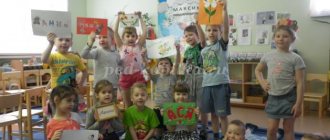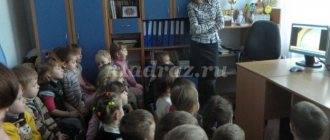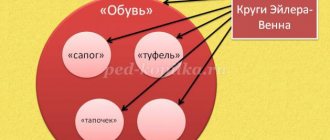Project at a preschool educational institution - what is it? Types of projects used in kindergarten.
Municipal budgetary preschool educational institution "Kindergarten for supervision and health improvement No. 108" in Saratov
Project at a preschool educational institution - what is it? Types of projects used in kindergarten.
Prepared by the teacher
I qualification category
Senina Yulia Viktorovna
2017
What is project work in kindergarten?
Back at the beginning of the twentieth century. Professor Collings, the organizer of a long-term experiment in one of the rural schools in Missouri, proposed the following classification of educational projects:
“game” - children’s activities, participation in group activities (games, folk dances, dramatizations, various types of entertainment);
“excursion” aimed at studying problems related to the surrounding nature and social life;
“narrative”, during the development of which children learn to convey their impressions and feelings verbally and in writing. Vocal (song), artistic (painting), musical (playing the piano) forms;
“constructive”, aimed at creating a specific useful product: putting together a birdhouse, a prepared children's breakfast, arranging flower beds.
By the end of the twentieth century. New types of projects have been developed. E. Polat (1999) characterizes projects in accordance with their typological characteristics: number of participants, dominant method, nature of contacts, method of coordination, duration.
Focusing on these signs, the author offers his own version of the typology of projects relevant for preschool education.
1. According to the dominant method: research, creative, informational, gaming, adventure, practice-oriented.
2. By the nature of the content: include the child and his family, the child and nature, the child and the man-made world; child, society and its cultural values.
3. According to the nature of the child’s participation in the project: customer, expert, performer, participant from the inception of the idea to the receipt of the result.
4. By the nature of contacts: carried out within one age group, in contact with another age group, within a preschool educational institution. In contact with family, cultural institutions, public organizations (open project).
5. By the number of participants: individual, pair, group and frontal.
6. By duration: short-term, medium-term (medium-term) and long-term).
The project sounds somehow official and scientific, doesn’t it? But in fact, this word hides the name of one of the methods for implementing tasks for the development and training of preschoolers. Project activity consists of the joint work of the teacher, parents and children to study a certain issue.
The purpose and purpose of the projects is to promote the development of independent thinking in children, the ability to make decisions, look for answers, plan, foresee the result and learn to cooperate with other people. The teacher gives some task to the children, feasible for their age, and teaches how to solve it and how to present the result of the solution.
Preschoolers cannot develop a project on their own; in kindergarten we do everything together. Typically, this type of activity is purely educational in nature; we use the project as a tool for learning, gaining knowledge and enriching life experience. This method has only recently begun to be used in preschool education; it is considered progressive and effective for modern children.
Development and learning in preschool format is carried out mainly through play activities, so projects have a creative, playful orientation. The most effective is group research activities of children.
The topics of the projects are very diverse.
Well, for example, the popular theme for children's projects is “Family Tree” or “My Family”. This project can be implemented in different ways - in the form of a collective panel with photographs of the family of each child in the group, or a painted large tree, or an exhibition of children's works on the theme of the children's family.
The point is not to give children a finished project, but to give them a topic and help them determine the path for implementing the project: what materials to use, who to ask for help, how to design the project product, how to present it. Moreover, this applies not only to children of the senior and preparatory groups. Kids also do projects that they can handle.
For those who want to create a project according to all the rules
The peculiarities of the pedagogical and educational system in Russia are such that every step we take must be strictly in accordance with the Federal State Educational Standard. Therefore, even such a creative task as writing a project requires compliance with the methodological recommendations of the Ministry.
In order not to search for information for a long time, I suggest looking at the UchMag online store, since there is absolutely any methodological literature, including excellent manuals on our topic:
- “Projects in preschool educational institutions: practice of teaching children 3-7 years old”;
- “Innovative pedagogical technologies. Project method in preschool educational institutions";
- “Projects in preschool educational institutions: theory and practice of child development”;
- “Projects in preschool educational institutions. Practice of teaching children 3-7 years old. Program for installation via the Internet";
- “Preschool educational institution development program. CD for computer: innovative educational project";
- “Environmental projects in preschool educational institutions. Research activities on walks."
For preschool teachers, taking into account modern requirements for a preschool teacher, in such manuals you can find everything that is necessary for competent planning and implementation of teaching activities: how to draw up a project, what to take into account, how to formalize the results, etc.
Types of projects in kindergarten
In current practice, kindergartens use the following types of projects:
- Research with a creative bent: the guys find out some information, for example, why snow melts in the spring, and the results are presented in the form of drawings, wall newspapers, staged skits, etc.;
- Creative tasks are also educational in nature, but the results of the research are presented in the form of a theatrical performance, a performance, or a children's party;
- Social and informational: the guys research the subject of the project and draw up the result in the form of a newspaper, folder, poster, installation;
- Role-playing or gaming: children solve a project task using a fairy tale familiar to them, getting used to the roles of the characters, presenting the result of the research in the form of a role-playing plot.
According to the method of project implementation, group, individual, intergroup, complex
Taking into account the age-related psychological characteristics of preschoolers, project coordination should be flexible, i.e. The teacher unobtrusively guides the children’s work, organizing individual stages of the project.
All projects are carried out within the preschool educational institution, as a rule, between groups of participants, but there are also personal, individual projects (in visual and verbal creativity). Since the leading activity of a preschooler is play, role-playing and creative projects are used from a young age: “Favorite Toys”, “The ABC of Health”, etc.
Other types of projects are also significant, including:
- complex: “World of Theater”, “Hello, Pushkin!”, “Echo of Centuries”, “Book Week”, etc.;
- intergroup: “Mathematical collages”, “World of animals and birds”, “Seasons”, etc.;
- creative: “My friends”, “In our Neskuchny Garden”,
“Favorite Tales”, “Natural World”, “Rowan Bins of Russia”, etc.;
- group: “Tales of Love”, “Know Yourself”, “Yugan Gems”, “Underwater World”, “Fun Astronomy”, etc.;
- individual: “Me and my family”, “Family tree”, “Secrets of grandma’s chest”, “Fairytale bird”, etc.;
- research: “The World of Water”, “Breath and Health”, “Nutrition and Health”, etc.
These projects may seem like they're too difficult for preschoolers. But preschoolers are just getting acquainted with this type of activity, preparing for independent research that they will conduct at school.
Research projects
According to E. Polat, they require a clear structure, defined goals, relevance of the subject of research for all participants, social significance, and thoughtful methods for processing the result. In recent years, research projects have been actively conquering the space of secondary schools and additional education institutions and are increasingly of interest to preschool specialists.
Information projects
Goals: collect information about some object, phenomenon, and then familiarize participants with it, analyze and summarize the observed facts.
Structure of the information project: obtaining and processing information, result (report, album with drawings and photographs), presentation.
Creative projects
They do not have a detailed structure for the joint activities of participants. It is just outlined, and then develops, subordinate to the final result, the interests of the project participants. Teachers and children agree on the form of presenting the results (fairy tale, film, dramatization, holiday, interior decoration). However, the presentation of the results of the project requires a clearly thought-out structure in the form of a film script or a concert program.
Creative projects are varied, as are the types of artistic and productive activities that children master. In content, they reflect the relationship: child - family; child - nature; a child is a man-made world; child – society and its cultural values.
Creative projects can be classified according to the predominant motive (expression of a subjective attitude, bringing joy, providing assistance, joint creativity or activity); by dominant type of creativity (game, visual, constructive, artistic and speech, artistic and design, theatrical, musical); according to the form of presentation of the result (panel, design, performance, decoration, cartoon, concert, holiday, presentation).
Game (adventure) projects
The structure of game projects is just being outlined; participants take on certain roles determined by their character and content. These can be literary characters or fictional characters that simulate social or business relationships in imaginary situations.
The degree of creativity in such projects is high, but the dominant type of activity is still role-playing.
Practice-oriented projects
They are distinguished by a clearly defined expected result of the participants’ activities, oriented towards social interests. A practice-oriented project requires a well-thought-out structure and organization of work at individual stages (adjusting efforts, discussing results and ways to implement them in practice, evaluating the project).
Open Projects
The most common design is within one age group. Teachers and children do not experience difficulties because they know each other’s creative capabilities and social qualities well; have an idea of the subject-spatial environment of the group. However, you should not isolate yourself in your team. Contacts with another age group are necessary for a child for his social development and expansion of the sphere of communication. Participation in a joint project with another group enriches children with new impressions, allows them to experience new emotions, and win sympathy from the people around them. A similar process occurs in a mixed-age group. In such conditions, younger preschoolers have the opportunity to master the world around them with the participation of their elders, and older children gain experience in behavior socially approved by adults.
It is more difficult to organize contacts and projects within preschool educational institutions (for example, “April Fool’s Day”, “Fairy Tale Week”). They require a high level of development of management (creative, organizational) skills among teachers, since it is necessary to identify the current problem, think through the conditions and form of children's or child-adult projects.
The most complex are open projects implemented in contact with family, cultural institutions, and public organizations. But it is they that give a high result in the development of the child, expanding the space of his life.
Individual and collective projects
Individual project - carried out independently, designed to enrich the child’s cultural experience; with its help, the ability to overcome obstacles in solving a problem (composing and illustrating a fairy tale) is monitored. The Value of Custom Design
is undeniable, since the child learns to take initiative, experience mistakes and achievements, and demonstrates abilities.
However, children are collectivists at heart; they want to interact with peers and adults. An essential feature of the psychological characteristics of any person is the ability to participate in collective activities and jointly find ways to solve problems. The formation of stable skills of collective cooperation in preschoolers is facilitated by the constant and purposeful involvement of children in the creation of common works. Children learn to unite in subgroups, discuss together ways to implement a plan, plan and coordinate their actions step by step, distribute responsibilities and tasks among themselves, help each other, worry about the quality of not only their part of the work, but the whole.
The experience of collective creativity is acquired against the background of joint positive emotional experiences that contribute to the development of friendly relationships between children.
Children feel unhappy when they are not in the group. Therefore, pair, group, frontal projects are necessary for children's development.
Pair project
- carried out by a pair (pairs) of participants. Children acquire cooperation skills, learn to act together in the same space, solve a common problem, and choose adequate solutions.
Group project
- carried out by a group of participants (from 3 to 10-12 people).
Frontal (collective) project
- performed by the whole team.
Short term projects
- aimed at solving a small problem or part of a larger one. They can be implemented in one or several specially organized classes, as part of joint activities with adults or independent children's activities (studying the properties of ice; studying the activities of an artist in a workshop).
Medium duration projects
- designed to solve the problem within several days, weeks (preparing for a holiday, travel); writing and staging a fairy tale).
Long-term projects
(from one to several months) - solve a major problem, which requires effort and sufficient time to overcome (for example, researching your ancestry).
Have you probably seen foreign films where children prepare some projects, often making volcanoes, various devices, bringing a pet to kindergarten and talking about it? Such types of activities are extremely useful for children, as they broaden their horizons, activate cognitive activity, and reveal creative and scientific abilities.
The name - projects - sounds very serious to our ears. In fact, for children this is just one type of work that requires research and presentation of the result. Both short-term and long-term projects are designed to increase the child’s self-esteem, since initially the adult is determined to recognize the value of any result of the child’s research.
The point is not to get an ideal research result from a child, say, on the topic of a favorite toy. The point is to instill in him an interest in research and analysis of the processes that occur around us. Arousing curiosity and healthy curiosity in children is the task of children's projects.
The tasks of research activities are specific for each age.
In early preschool age this is:
— children’s entry into a problematic play situation (the leading role of the teacher);
— intensifying the desire to look for ways to resolve a problem situation (together with the teacher);
— formation of initial prerequisites for research activities (practical experiments).
In older preschool age this is:
— formation of prerequisites for search activity and intellectual initiative;
- developing the ability to determine possible methods of solving a problem with the help of an adult, and then independently;
— developing the ability to apply these methods to help solve the problem, using various options;
— developing a desire to use special terms, conducting a constructive conversation in the process of joint research activities.
Thus, the project method in working with preschoolers today is an optimal, innovative and promising method that should take its rightful place in the preschool education system. The methodological foundations of project activities discussed above give an idea of the high degree of adaptability of innovative technologies to the specifics of preschool educational institutions.
Using the project method in preschool education as one of the methods of integrated teaching of preschoolers can significantly increase children's independent activity, develop creative thinking, children's ability to independently find information about an object or phenomenon of interest in different ways and use this knowledge to create new objects of reality. It also makes the educational system of preschool educational institutions open to the active participation of parents.
The specificity of using the project method in preschool practice is that adults need to “guide” the child, help discover a problem or even provoke its occurrence, arouse interest in it and “draw” children into a joint project. Based on a person-centered approach to training and education, ultimately, it should contribute to the development of individual creative activity of teachers in the development of strategy, tactics and technology of the educational process, promote the personal development of students, and ensure high-quality results of teaching activities.
The promise of the project method in the preschool educational system is that it provides the opportunity to develop observation and analysis of phenomena, comparison, generalization and the ability to draw conclusions, creative thinking, logic of knowledge, inquisitiveness of mind, joint cognitive-search and research activities, communication and reflective skills and much more that are components of a successful personality.
The relevance of project activities in preschool institutions
Olga Danilenko
The relevance of project activities in preschool institutions
Nowadays in the pedagogical environment and in particular in preschool , a lot of attention is paid to design - pedagogical and children's. And for many teachers it is not entirely clear why design is needed in kindergartens . In this article I will try to explain and reveal the relevance of projects in working with children . The desire to observe and experiment, to independently seek new information about the world are the most important features of normal child behavior. Research and search activity is the natural state of a child. Children's need to search is biologically determined. Every healthy child is a little explorer from birth. He is determined to understand the world, he wants to get to know it as best as possible. It is this internal desire for research that gives rise to exploratory behavior and creates the conditions for the child’s mental development to initially develop in the process of self-development. The project-based teaching method is innovative for preschool institutions. It is aimed at developing the child’s personality, his cognitive and creative abilities. Project activities, like no other, support children's cognitive initiative in kindergarten and family settings. This topic is very relevant for a number of reasons .
Firstly, it helps the child gain early social positive experience in realizing his own plans. If what is most significant for a child is also of interest to other people, he finds himself in a situation of social acceptance, which stimulates his personal growth and self-realization.
Secondly, the ever-increasing dynamism within social relationships requires the search for new, non-standard actions in a variety of circumstances. Non-standard actions are based on originality of thinking. Thirdly, project activities help to go beyond the boundaries of culture (cognitive initiative)
culturally - in an adequate way.
It is project activity that allows not only to support children’s initiative, but also to formalize it in the form of a culturally significant product. Also, the topic of the project method is relevant for a number of reasons :
- federal state requirements (FSES)
to the structure of the basic general education program
of preschool education, they say that the program of a preschool educational institution should be built taking into account the principle of integration of the educational field in accordance with age capabilities and the specifics of educational fields.
— a person must, as early as possible, gain positive social experience in realizing his own plans.
— the ever-increasing dynamism of economic and social relations requires the search for new, non-standard actions in a variety of circumstances. Non-standard actions are based on originality of thinking.
Project activities of both teachers and preschoolers significantly change interpersonal relationships between peers and between adults and children. All participants in project activities gain experience in productive interaction, the ability to hear others and express their attitude to various aspects of reality. A new round of interest in the project as a way of organizing life activities is explained by its potential integrativity, compliance with developmental education technology, and ensuring children’s activity in the educational process. What is the modernization of education, in particular preschool ? According to T. A. Danilina (a well-known scientist in the field of psychology and pedagogy, pedagogical design arises in response to the social order for education and is carried out on the basis of pedagogical foresight and forecasting, serves as the process and result of the development of a scientifically based model of the rational characteristics of specific socio-pedagogical objects or their states in terms of solving certain social and pedagogical problems. Pedagogical design can become a way to develop the ability to exist in a field of uncertainty, a space that requires development. A modern teacher must have the knowledge and skills of pedagogical design and organization of project activities aimed at transforming the future in the field of education and education of preschoolers ... Thus, using in our work pedagogical design , and in working with preschoolers , the methodology of working with children to organize project activities project-based learning technology )
, we implement a personality-oriented and developmental approach to training and education.
Project activities allow us to :
1. Increase the professional level of teachers and the degree of their involvement in activities , make the team more united;
2. Form professional interaction between teachers and preschool children, which is based on the subjective attitude of the teacher to the child, an individual approach, taking into account the child’s zone of proximal development, a motivational approach, a friendly attitude towards the child, develop a system of productive interaction between participants in the educational process (children are involved in the project parents communicate with each other and with the teacher, and during pedagogical design all participants in the educational space of the kindergarten communicate with each other), as well as the scientific principles of constructing the basic general education program are implemented and the integrative qualities of the child are developed, which are the final results of the children’s mastery of the educational program.
The project-based teaching method promotes the development of independent thinking, helping the child to build confidence in himself and his own capabilities. It provides for a system of education in which children acquire knowledge and master skills in the process of completing a system of planned practical tasks. This is learning through search and cognitive activity , which is aimed at the result that is obtained when solving a problem. project method allows you to raise an independent and responsible personality, develop the child’s creative and mental abilities, and also promotes the development of determination, perseverance, teaches you to overcome problems that arise along the way, and most importantly, the ability to communicate with peers and adults, increases the child’s authority before peers and his own self-esteem . At the heart of every project lies some kind of problem. After all, the themes of the projects are born precisely from the interests of children
project method was reflected in the ideas of domestic scientists of the 20s: B.V. Ignatiev, V.N. Shulgin, N.K. Krupskaya. And recently, the theoretical foundations for the design of individual educational systems and technologies have been actively developed in scientific and pedagogical literature (V. S. Bezrukov, V. P. Bespalko, V. I. Zvyaginsky)
.As an option for an integrated method of teaching
preschoolers, a number of scientists consider project activities , such as T. A. Danilina, M. B. Zuikova, L. S. Kiseleva, T. S. Lagoda, etc.
The use of the project method in preschool education makes it possible to significantly increase children's independent activity. project method becomes a way of organizing the pedagogical process, based on the interaction of the teacher, parents and pupils with each other and the environment, and also makes the educational system of preschool institutions more open to the active participation of parents. Consequently, the project method is relevant not only for kindergarten, but also for society and the family as a whole.
Summary
The promise of the project method in the preschool educational system is that it provides the opportunity to develop observation and analysis of phenomena, comparison, generalization and the ability to draw conclusions, creative thinking, logic of knowledge, inquisitiveness of mind, joint cognitive-search and research activities , communication and reflective skills and much more that are components of a successful personality.
A promising method in the DOE system is that it allows the development of observation and analysis of phenomena, comparisons, generalizations, and skills to draw conclusions, creative thinking, logic of knowledge, inquisitive mind, a joint educational and research activities, communication and reflective skills, and much more, what are the ingredients of a successful personality.
Literature
1. Borovleva A. V. Project method - as a means of improving the quality of education / A. V. Borovleva // Preschool educational institution management. - 2006. - No. 7.
. Veraksa N. E. Project activities of preschoolers . Manual / N. E. Veraksa, A. N. Veraksa. - M.: Mozaika-Sintez, 2008. - 112 p.
. Vinogradova N. A. Educational projects in kindergarten . Manual / N. A. Vinogradova, E. P. Pankova. - M.: Iris-Press, 2008. - 208 p.
. Evdokimova E. S. Design technology in preschool educational institutions / E. S. Evdokimova. - M.: TC Sfera, 2006. - 64 p.
Danilina T. A., Zuikova M. B., Kiseleva L. S., Lagoda T. S., Project method in the activities of preschool institutions : A manual for managers and practitioners of preschool educational institutions







